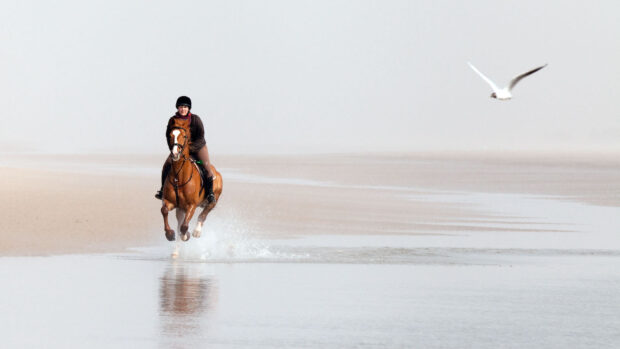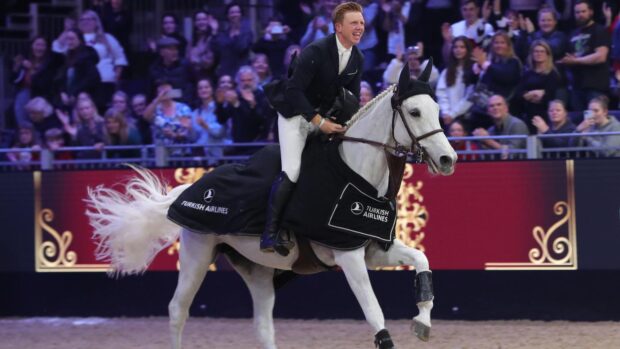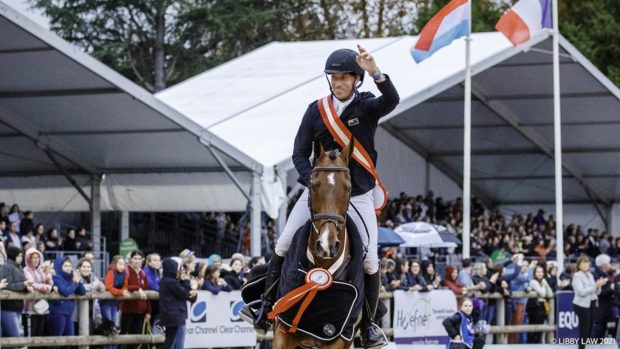If you’re a rider on a schedule who wants an easy way to test and improve your riding independence, no stirrup exercises for balance are an ideal place to start.
“As a rider, balance isn’t about grip or having a stirrup on the ball of your foot,” says Charlie Hutton, international grand prix dressage rider, British Equestrian Podium Potential Pathway and UKCC Level 3 coach.
“A balanced rider should feel like they are absorbing the horse’s movement. The moment you start to grip, it creates tension. That tension results in compensation elsewhere in the body in a bid to keep you secure.
“In the short term, this might be effective. Long term, you could develop body pain or one-sidedness.”

A rider in good balance, trotting without stirrups. Credit: Emma Herrod Photography
Why no-stirrup exercises?
Charlie says riding without stirrups is a two-fold mission. The first is fact-finding.
“Just how secure do you feel? Can you do it without your inner thighs immediately tiring?” he asks. “In this way, it’s a suppleness test as well as an assessment of your balance in the saddle.”
Secondly, it gives you a truer feeling of what you should be aiming for – provided you can relax. “It gives you a stronger idea of how following the horse’s movement should feel, and is something you can try to mimic when you take your stirrups back.”
Exercise 1: Transitions
Start on a 20m circle – this will help with speed control and make balancing easier.
Begin with walk-trot and trot-walk transitions. Ride forward, but don’t let the trot become big. Focus on riding a quality transition rather than staying on – it’ll help you avoid overcompensating.
Once that feels easy, progress to transitions on the long side. Maintain that same forward yet manageable rhythm – a more open stride will complicate matters.
Return to a circle and progress to trot-canter and canter-trot. Again, aim for precise transitions.

Once you have mastered walk-trot transitions, have a go at trot-canter-trot, only progressing when you are ready. Credit: Emma Herrod Photography
How it helps
No-stirrup exercises incorporating transitions highlight the importance of absorbing your horse’s movement – which means stability rather than grip.
“Each part of the rider has a job; there are parts of the body that need to be stable and others that need to be mobile,” Charlie explains. “For example, the ankles and hips need to move, the knees must be stable.”
A clear sign you’re exhibiting tension rather than stability? According to Charlie, you’ll bounce more and have tension through your lower back.
Things to avoid
Charlie advocates not running before you can walk.
“I’d rather a rider go slower and build up progressively,” says Charlie, “Ride forward, but stay in a gear you can manage and where you won’t be fighting to contain your horse. A big, forward downward transition is where you’ll struggle with balance the most, so walk and trot first.”
Exercise 2: Rising trot without stirrups
Begin on a circle once you’ve warmed up and settled into your no-stirrup work.
Ensure your horse is in a comfortable gear (that is, you’re still able to ride forward without it feeling bouncy or so onward bound that you feel like you’re having to ride backwards to contain him).
Keeping your knees steady without pinching them together, use the lift in your horse’s stride to help propel your rise.

Rising trot with no stirrups is a physically demanding exercise: keep the rise small so you can influence the rhythm and tempo. Credit: Emma Herrod Photography
How it helps
Like all no stirrup exercises, it helps riders learn to absorb their horse’s movement and acquire stability without tensing up. Rising trot without stirrups is also a great strength and conditioning exercise.
Things to avoid
Charlie warns against rising too high.
“Rising trot without stirrups actually helps you realise you’re more connected to your horse with a shallower rise,” he explains. “Riders often rise high in an attempt to absorb the movement, but it’s actually less effective in influencing the rhythm and tempo.”
Riders should also be cautious. As you’ll discover, rising trot without stirrups requires strength and stamina, so don’t worry about taking breaks.
Exercise 3: Bareback
While riding with a correctly fitting saddle is essential, taking it away allows the rider to feel what’s happening through the horse’s body more obviously.
Riding bareback, or riding without a saddle, should only be done if you feel confident to and in an enclosed space such as an arena.
There aren’t really any steps to follow; you could take off your horse’s saddle and remount to cool him down at the end of a ride or embark on a full saddle-less schooling session. Do whatever matches your confidence and experience level.

Riding bareback can feel daunting, but if you feel confident to try (within an enclosed area), it will develop both balance and trust in the horse-rider partnership. Credit: Emma Herrod Photography
How it helps
“Riders can feel quite vulnerable when riding bareback, especially if they haven’t tried it since childhood or are coming to it new,” says Charlie. “That is an indication of how a rider feels about their own balance, and how much they rely on the saddle to support them.”
In this way, riding bareback (or the thought of doing so!) might tell you that you’d benefit from more no-stirrup exercises to boost your security.
Charlie adds that riding bareback, or building up to it, requires the cultivation of a strong partnership with your horse.
“It highlights how much the rider trusts the horse,” he remarks.
While the relationship with a horse isn’t directly related to balance, the ability to relax and absorb his movement can’t be done if a rider is tense.
Things to avoid
Charlie advises reserving this exercise for established horses, not youngsters or horses only just coming back into work. It’s also not recommended for horses with known back problems.





